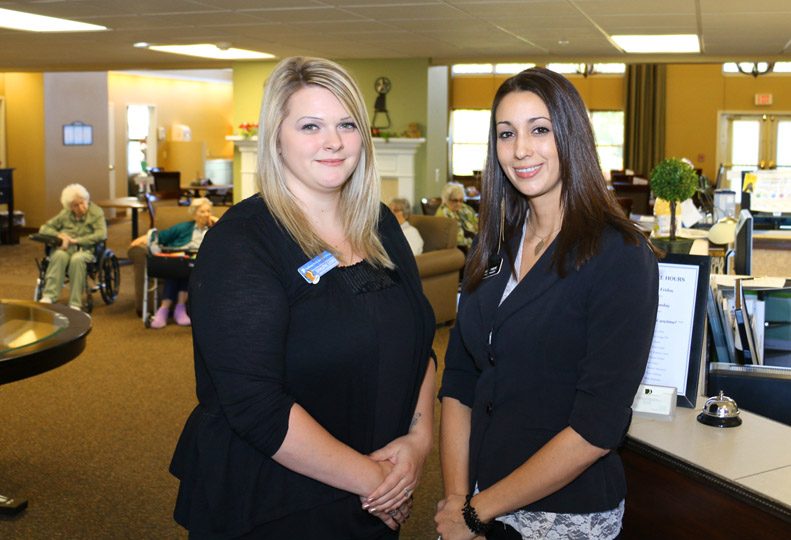
Home » Valley assisted-living facility 'celebrates' activities
Valley assisted-living facility 'celebrates' activities
Program aims to enhance cognitive, physical abilities

September 22, 2016
Sullivan Park Assisted Living Community, in Spokane Valley, recently launched a health and wellness program called Celebrations, which managers there say is helping aging adults optimize their mental cognition and physical strength.
Most residents at the facility are participating in the Celebrations program, says Kristi Fridye, office manager and interim executive director at Sullivan Park Assisted Living.
Fridye says the program activities are tailored to individuals, so everyone can participate regardless of physical and cognitive abilities.
“Since the program was implemented, there’s been a huge increase in participation in activities,” she says.
Sullivan Park Assisted Living, a 44-unit facility located at 421 S. Adams, is one component of the Sullivan Park Campus of Care, which also includes Sullivan Park Cottages independent-living homes and the Sullivan Park Care Center skilled nursing facility.
Sullivan Park Assisted Living and the 21-unit Sullivan Park Cottages are operated by Vancouver, Wash.-based Prestige Senior Living LLC. The skilled nursing facility, which includes 125 beds in a mix of private and shared units, is operated by a separate affiliate, Prestige Care Inc.
The assisted-living facility has a staff of 32, 12 of whom are full-time employees.
Fridye says the Celebrations program has garnered positive responses from residents and the community.
Many activities and events are open to residents’ families and friends in the community, she says.
“Anyone over 65 is invited to join in the events,” she says, adding that most are free of charge.
One of the initial Celebrations activities at Sullivan Park Assisted Living was a paint-and-sip session featuring wine and instructor-led group painting.
Other planned activities include a root beer-making course and a speaker series celebrating past adventures.
Through the Celebration program, Sullivan Park’s wellness team works with residents to assess their risk of falling and address problem areas through strength and balance classes.
The program also includes instructional components. For example, a physician presented a fall-prevention seminar, and suggested exercises to help residents maintain mobility in their homes.
“We’re seeing a decrease in falls,” Fridye says. “Exercise reduces the chance for injuries and hospital visits.”
Other components are aimed at improving or maintaining cognitive skills.
The Celebrations program includes a measure of technology through Linked Senior, a cloud-based online therapy engagement platform through which seniors can navigate challenging and interesting digital courses that engage their minds on many levels.
Residents often see improvement in concentration and even the ability to make new memories, Fridye claims.
One activity includes the use of the Google Earth program to call up images of geographical places to help trigger certain memories.
“It’s neat to watch when it sparks memories,” Fridye says.
The Celebrations program also incorporates and enhances routine daily activities.
Scheduled activities during a recent Friday included a walk around the neighborhood, cow pie BINGO, and a movie.
A typical day of scheduled activities for cottage residents includes group exercise, an arts-and-crafts activity, BINGO, and Wii Games.
Shalene Lewis, communications director at Sullivan Park Assisted Living, says the Celebrations program enhances quality of life. She says the proactive program is important, because the average age of residents moving into Sullivan Park has been on the rise over the last decade.
“We’re accepting a lot of high-level-of-care and medically compromised adults,” Lewis says.
Residents currently living in the assisted-living facility range in age from 74 to 101.
Residents in the independent-living cottages range in age from 71 to 93.
The occupancy rate at the 20-year-old, assisted-living facility has averaged 94 percent this year and for a couple of months in the spring was at 100 percent, Lewis says, adding that the cottages typically are full.
The average length of stay for assisted-living residents is two to three years, although one resident has been there for nine years, Lewis says. The average length of stay for independent residents is five to eight years.
The assisted-living apartments include studio, one-bedroom, and two-bedroom units with living space ranging from 380 to 830 square feet and monthly rents ranging from $3,300 to $4,600.
Fees for assistance with daily activities range from an additional $500 to $2,000 a month, depending on level of care needed.
The base rent includes three daily meals, weekly housekeeping, basic cable TV, a full activity schedule, and basic transportation.
Sullivan Park Assisted Living accepts Medicaid for qualifying residents after at least two years of paying privately, Lewis says.
The independent Cottages at Sullivan Park consist of one-bedroom units with 850 square feet of living space, and two-bedroom units with 1,150 square feet of space. The one-bedroom units rent for $2,000 a month, and the two-bedroom units rent for $2,300 a month.
All cottages are private pay, Lewis says.
Monthly rent includes weekly housekeeping with linen service, routine maintenance and landscape services, scheduled activities, and weekly transportation for shopping and appointments.
Cottage residents can purchase meal plans, which range in price from an additional $200 for a one daily meal plan to $400 for a three daily meal plan.
Lewis says it takes about two weeks for new residents to become acclimated at Sullivan Park. During that time, each new resident is assigned a staff member who documents and helps with the resident’s concerns.
“We build relationships with residents and family members,” Lewis says. “It’s humbling to meet new people and help families in need.”
New residents also are paired with another compatible resident to help them with orientation.
“Our activity director works with residents to bring them out,” Lewis says. “Our job is to get them on their feet and excited. That’s one of the reasons for the Celebrations programs.”
Prestige Senior Living and Prestige Care operate more than 70 facilities in eight states, including three other facilities in the Inland Northwest.
Latest News Special Report
Related Articles




